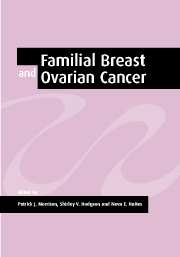Book contents
- Frontmatter
- Contents
- List of contributors
- Foreword by Helena Kennedy
- Preface
- Acknowledgements
- Part 1 Molecular biology and natural history
- 1 Introduction
- 2 Overview of the clinical genetics of breast cancer
- 3 Cowden syndrome and related disorders
- 4 Overview of the clinical genetics of ovarian cancer
- 5 Ovarian and breast cancer as part of hereditary non-polyposis colorectal cancer (HNPCC) and other hereditary colorectal cancer syndromes
- 6 The natural history of hereditary breast cancer
- 7 Pathology of the breast and ovary in mutation carriers
- 8 Risk estimation for familial breast and ovarian cancer
- Part 2 Screening
- Part 3 Management
- Index
8 - Risk estimation for familial breast and ovarian cancer
Published online by Cambridge University Press: 24 August 2009
- Frontmatter
- Contents
- List of contributors
- Foreword by Helena Kennedy
- Preface
- Acknowledgements
- Part 1 Molecular biology and natural history
- 1 Introduction
- 2 Overview of the clinical genetics of breast cancer
- 3 Cowden syndrome and related disorders
- 4 Overview of the clinical genetics of ovarian cancer
- 5 Ovarian and breast cancer as part of hereditary non-polyposis colorectal cancer (HNPCC) and other hereditary colorectal cancer syndromes
- 6 The natural history of hereditary breast cancer
- 7 Pathology of the breast and ovary in mutation carriers
- 8 Risk estimation for familial breast and ovarian cancer
- Part 2 Screening
- Part 3 Management
- Index
Summary
Introduction
The awareness of genetic predisposition to breast cancer has increased tremendously since the identification of the two highly penetrant breast and ovarian cancer genes – BRCA1 and BRCA2 (Miki et al., 1994; Wooster et al., 1995). Women with a family history of breast cancer are particularly concerned about their own risk, thus creating a greater demand for risk assessment and genetic counselling as well as for genetic testing. Mutations in BRCA1 or BRCA2 account for the majority of high-risk families in which the segregation of a dominant high-penetrance susceptibility gene has quite clearly manifested itself in multiple cases of breast cancer over several generations of close relatives (Ford et al., 1998). Only a small proportion of families with a less striking family history and isolated early-onset breast cancer can also be attributed to mutations in these genes (Frank et al., 1998; Malone et al., 1998; Newman et al., 1998) except in founder populations with recurrent mutations (Andersen et al., 1996; Johannesdottir et al., 1996; Fodor et al., 1998; Thorlacius et al., 1998). Screening for mutations is, however, still a technically demanding and labour-intensive task, and gene testing is usually only offered to persons with a greater than three-fold increase in risk compared with the general population (Gayther and Ponder, 1997). Generally, for genetic counselling on familial breast cancer, an accurate evaluation is needed of the probability that a woman carries a mutation before any decisions are made regarding genetic testing.
- Type
- Chapter
- Information
- Familial Breast and Ovarian CancerGenetics, Screening and Management, pp. 125 - 140Publisher: Cambridge University PressPrint publication year: 2002



